Smokin Moose
Fallen Cannabis Warrior & Ex Moderator
New cylindrical grow system packs more buds into less space.
Can you imagine growing a crop with four times the yield of your buddy's fine-tuned flat garden, without using any more light or area? Pinch yourself because that dream can come true. An inventor/grow guru has invented an easy-to-use circular garden to do just that. It's called "The Cage."
The inventor is "DDoc" of Vancouver BC's Westside Technology Inc. He's down-to-earth and friendly to talk to, but should the topic of hydroponic growing come up you realize he's light years beyond all but a select few. He has a unique combination of years of practical experience, in-depth theoretical knowledge and engineering savvy.
How does The Cage system work? Simply put, his garden gives cannabis plants plenty of what they crave — air, water and food for the roots and intense light for the foliage. A nutrient solution is pumped to the top of twelve narrow columns which surround the central lights. Each column contains six plant sites, and the nutrients cascade down over the roots to the reservoir at the bottom of the system. This is the Cascading Film Technique, a vertical variation of the Nutrient Film Technique.
The system's lighting is elegantly engineered to leverage out more yield in two ways. First, by having plants all around a cylindrical light source at close range, the light output from any single light is used more efficiently than in a flat garden or stadium setup. The plants are situated all around the light; you get high intensity light on three times the foliage, where it matters most, instead of being wasted on a reflector or wall. Secondly, the light coverage from multiple lights will overlap and work in combination. Overlapping light from adjacent lamps will ensure superb coverage and intensity over the entire plant canopy.
The cage only takes up a five by five foot area, with less than seven feet of ceiling space. Yet in the right hands this device can grow 72 plants and pump out over five pounds per harvest.
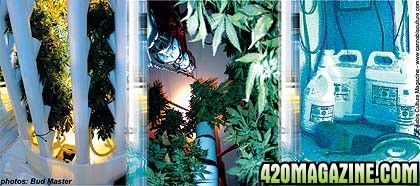
Circulation equation
Although recirculating the solution will give very good results, Cage inventor DDoc recommends a drain-to-waste setup and fine-tuning the feeding schedule to conserve nutrients. This way you can avoid the potential problems of recirculation, such as the nutrient solution getting too warm, or the build-up of root pathogens. To employ the drain-to-waste method you will likely need an external reservoir — a 55 gallon barrel works very well for that.
If you want to recirculate your nutrient solution that's fine, but keep in mind that the nutrient solution temperature should be kept between 16-24°C (60-75°F) to prevent problems with root pathogens. One way to cool your nutrient solution without affecting its concentration is to freeze water in closed containers, such as plastic pop bottles with their labels removed, and then place into the reservoir as needed. All remaining solution should be replaced every three to seven days to ensure proper levels of nutrients.
A good initial feeding schedule with a medium of expanded clay pellets would be to have the timer turn on the pump for 30 seconds every six hours for smaller plants, and 30 seconds every three hours for larger plants. You could fine-tune the schedule from these starting points depending on your medium, room temperature, humidity, carbon dioxide level, and nutrient mix.
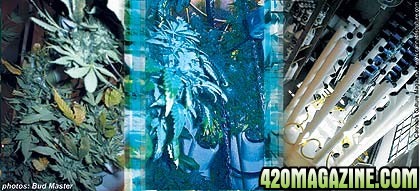
Medium massage
When using the Cage you have a wide choice of mediums, including growing aeroponically, which means using a water mist in air.
An excellent medium for a recirculating setup is expanded clay pellets. The clay pellets retain moisture, and compared to an aeroponic setup they will give you more time to recover without harm if a serious problem occurs (like a pump failure). Also, clay pellets cannot be over watered and they can be reused indefinitely if sterilized after each harvest.
For a drain-to-waste setup, a better medium would be a mix of 80% clay pellets with 10% coconut husk fiber, 4% worm castings, and 2% each of bat guano, greensand and kelp. This mix will retain more water and so allows you to be more water efficient, by draining out only 10% of the solution going in rather than the 20-30% with clay pellets alone. It also gives you a bigger safety margin if your pump cavitates. The flavour of the buds may also be preferable with this mix, but the yield may be slightly lower than with clay pellets alone.
Pump and light
The Cage works best with four 250 watt lights. 1000 watts in total will produce an excellent yield, help to keep your grow room cooler and prevent any yellowing problems. You could put in four 400 watt lights if you wanted to, but then you should watch for abnormal yellowing of the leaves and be ready to feed more nitrogen. Anything more than 1600 watts in total will likely burn the plants.
A system is only as good as the pump you use because if your pump sucks air and gets vapour locked, you will lose your roots after about 48 hours in a clay pellet medium. This is why it is suggested you check your system once every day.
The standard Cage kit includes the Little Giant Water Wizard, a 1200 gallons per hour pump chosen because they are small, powerful and perfectly suited to intermittent operation.
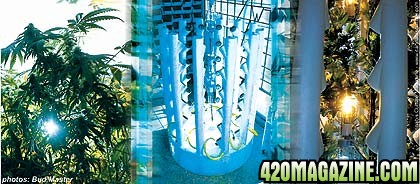
Life cycles
Take care not to give your clones or seedlings more light or blowing air than they can handle. Start them one to two feet away from cool white fluorescent lights until they develop roots and are able to handle the intense light of The Cage at full throttle. You could also try using just two lights in The Cage for about a week, before turning on all four of the lights for the remaining growth.
Keep the nutrient level at 300 to 600 parts per million while the clones are small, then gradually increase it.
Begin the flowering stage when the height of the plants is in the eight to twelve inch range. In tests, this size range produced the greatest yields. If the plants are much bigger than this you can still expect a good yield, however the Cage will become overgrown and there will be too much overlap.
The ideal height of a plant in the Cage at maturity is 18 inches. With the right strains you can fill up the space allotted to each plant and get a cola 12 to 14 inches long and 8 to 10 inches wide, without too much overlap.
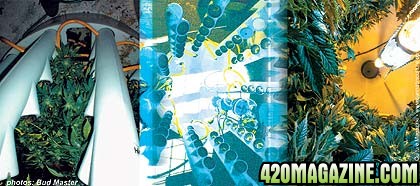
Any strain that grows to a short height in a Christmas tree-like shape is ideal for The Cage. This includes strains like Afghani, Baldy, Northern Lights, Shiraz, Skunk, Special K and most pure Indicas.
Using four 250 watt lights, a beginner should be able to harvest at least seven to 15 grams per plant, for a total of about 1.5 to three pounds, dried weight. A skilled grower should be able to get 14 to 25 grams per plant, for a harvest of three to five pounds. Some experts claim to take harvests of up to eight pounds, an astonishing 40 grams per plant, dried weight.
Using four 400 watt lights will boost your harvest by about 20%, if you successfully avoid the problems associated with too much heat. Using any lights over 400 watts will almost certainly damage your plants in this system.
A phat future
DDoc is proud of his creation and claims that cylindrical growing will be the dominant grow technique of the future.
"I think in the future indoor cannabis is going to be grown mainly in two ways," he explains. "First, the people who want high production in a quick time will grow with something like The Cage or an Omega Garden (a cylindrical garden which I have not tested). If your number of plants per square foot is about one or more, cylindrical gardens are the way to maximize your yield.
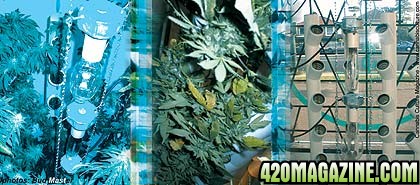
"Alternatively, people who are scared of having many plants will grow big plants, like one plant for every 1000 watts of lighting. Growing big plants is less work (you have only one plant for roughly every pound that you pull out). If certain people come into your garden and try to give you a criminal record, they count the number of plants you have and not necessarily the amount of light or harvest. So then you get arrested with six plants, instead of six thousand plants.
"Until our light sources radically change we are going to be growing plants around a cylindrical light source, even if one day the current bulb designs get a lot bigger. I think future space stations will be built with a cylindrical circulating design around a central light source.
"There's only one more efficient shape than a cylindrical source for using light and that's a sphere around a point source. But you can't rotate a sphere in all three directions and mimic gravity very well. With a cylinder you rotate it one way on one axis and you mimic gravity for yourself and the plants. You put the light source in the center. It's the most effective design for plant growth, maybe even into the next millennium."
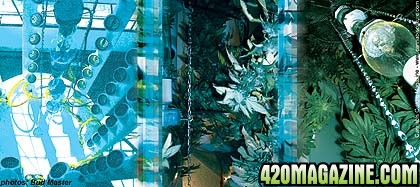
Quick cage
- 4' diameter and 5'7" tall
- works best with 1 foot of space around each Cage
- needs minimum ceiling of 6'9"
- 72 plant sites (fewer if desired)
- cylindrical light source for greater efficiency
- side lighting of plants for more light penetration
- no light reflectors needed
- four times the yield of flat gardens, per square foot of space
- two to four times higher yield per unit of light
- yields between 2 and 6 pounds dry bud weight
- wide choice of mediums, from soil to aeroponics
- easy to reach plants for trimming and spraying
- no moving parts other than water pump
- disassembles in five minutes
- Suggested retail price $1700 US. (price includes water pump, timer, nutrients, mesh baskets, and all plumbing installed. Lights, tax and shipping are extra.)
by Captain Kaieda
Can you imagine growing a crop with four times the yield of your buddy's fine-tuned flat garden, without using any more light or area? Pinch yourself because that dream can come true. An inventor/grow guru has invented an easy-to-use circular garden to do just that. It's called "The Cage."
The inventor is "DDoc" of Vancouver BC's Westside Technology Inc. He's down-to-earth and friendly to talk to, but should the topic of hydroponic growing come up you realize he's light years beyond all but a select few. He has a unique combination of years of practical experience, in-depth theoretical knowledge and engineering savvy.
How does The Cage system work? Simply put, his garden gives cannabis plants plenty of what they crave — air, water and food for the roots and intense light for the foliage. A nutrient solution is pumped to the top of twelve narrow columns which surround the central lights. Each column contains six plant sites, and the nutrients cascade down over the roots to the reservoir at the bottom of the system. This is the Cascading Film Technique, a vertical variation of the Nutrient Film Technique.
The system's lighting is elegantly engineered to leverage out more yield in two ways. First, by having plants all around a cylindrical light source at close range, the light output from any single light is used more efficiently than in a flat garden or stadium setup. The plants are situated all around the light; you get high intensity light on three times the foliage, where it matters most, instead of being wasted on a reflector or wall. Secondly, the light coverage from multiple lights will overlap and work in combination. Overlapping light from adjacent lamps will ensure superb coverage and intensity over the entire plant canopy.
The cage only takes up a five by five foot area, with less than seven feet of ceiling space. Yet in the right hands this device can grow 72 plants and pump out over five pounds per harvest.

Circulation equation
Although recirculating the solution will give very good results, Cage inventor DDoc recommends a drain-to-waste setup and fine-tuning the feeding schedule to conserve nutrients. This way you can avoid the potential problems of recirculation, such as the nutrient solution getting too warm, or the build-up of root pathogens. To employ the drain-to-waste method you will likely need an external reservoir — a 55 gallon barrel works very well for that.
If you want to recirculate your nutrient solution that's fine, but keep in mind that the nutrient solution temperature should be kept between 16-24°C (60-75°F) to prevent problems with root pathogens. One way to cool your nutrient solution without affecting its concentration is to freeze water in closed containers, such as plastic pop bottles with their labels removed, and then place into the reservoir as needed. All remaining solution should be replaced every three to seven days to ensure proper levels of nutrients.
A good initial feeding schedule with a medium of expanded clay pellets would be to have the timer turn on the pump for 30 seconds every six hours for smaller plants, and 30 seconds every three hours for larger plants. You could fine-tune the schedule from these starting points depending on your medium, room temperature, humidity, carbon dioxide level, and nutrient mix.

Medium massage
When using the Cage you have a wide choice of mediums, including growing aeroponically, which means using a water mist in air.
An excellent medium for a recirculating setup is expanded clay pellets. The clay pellets retain moisture, and compared to an aeroponic setup they will give you more time to recover without harm if a serious problem occurs (like a pump failure). Also, clay pellets cannot be over watered and they can be reused indefinitely if sterilized after each harvest.
For a drain-to-waste setup, a better medium would be a mix of 80% clay pellets with 10% coconut husk fiber, 4% worm castings, and 2% each of bat guano, greensand and kelp. This mix will retain more water and so allows you to be more water efficient, by draining out only 10% of the solution going in rather than the 20-30% with clay pellets alone. It also gives you a bigger safety margin if your pump cavitates. The flavour of the buds may also be preferable with this mix, but the yield may be slightly lower than with clay pellets alone.
Pump and light
The Cage works best with four 250 watt lights. 1000 watts in total will produce an excellent yield, help to keep your grow room cooler and prevent any yellowing problems. You could put in four 400 watt lights if you wanted to, but then you should watch for abnormal yellowing of the leaves and be ready to feed more nitrogen. Anything more than 1600 watts in total will likely burn the plants.
A system is only as good as the pump you use because if your pump sucks air and gets vapour locked, you will lose your roots after about 48 hours in a clay pellet medium. This is why it is suggested you check your system once every day.
The standard Cage kit includes the Little Giant Water Wizard, a 1200 gallons per hour pump chosen because they are small, powerful and perfectly suited to intermittent operation.

Life cycles
Take care not to give your clones or seedlings more light or blowing air than they can handle. Start them one to two feet away from cool white fluorescent lights until they develop roots and are able to handle the intense light of The Cage at full throttle. You could also try using just two lights in The Cage for about a week, before turning on all four of the lights for the remaining growth.
Keep the nutrient level at 300 to 600 parts per million while the clones are small, then gradually increase it.
Begin the flowering stage when the height of the plants is in the eight to twelve inch range. In tests, this size range produced the greatest yields. If the plants are much bigger than this you can still expect a good yield, however the Cage will become overgrown and there will be too much overlap.
The ideal height of a plant in the Cage at maturity is 18 inches. With the right strains you can fill up the space allotted to each plant and get a cola 12 to 14 inches long and 8 to 10 inches wide, without too much overlap.

Any strain that grows to a short height in a Christmas tree-like shape is ideal for The Cage. This includes strains like Afghani, Baldy, Northern Lights, Shiraz, Skunk, Special K and most pure Indicas.
Using four 250 watt lights, a beginner should be able to harvest at least seven to 15 grams per plant, for a total of about 1.5 to three pounds, dried weight. A skilled grower should be able to get 14 to 25 grams per plant, for a harvest of three to five pounds. Some experts claim to take harvests of up to eight pounds, an astonishing 40 grams per plant, dried weight.
Using four 400 watt lights will boost your harvest by about 20%, if you successfully avoid the problems associated with too much heat. Using any lights over 400 watts will almost certainly damage your plants in this system.
A phat future
DDoc is proud of his creation and claims that cylindrical growing will be the dominant grow technique of the future.
"I think in the future indoor cannabis is going to be grown mainly in two ways," he explains. "First, the people who want high production in a quick time will grow with something like The Cage or an Omega Garden (a cylindrical garden which I have not tested). If your number of plants per square foot is about one or more, cylindrical gardens are the way to maximize your yield.

"Alternatively, people who are scared of having many plants will grow big plants, like one plant for every 1000 watts of lighting. Growing big plants is less work (you have only one plant for roughly every pound that you pull out). If certain people come into your garden and try to give you a criminal record, they count the number of plants you have and not necessarily the amount of light or harvest. So then you get arrested with six plants, instead of six thousand plants.
"Until our light sources radically change we are going to be growing plants around a cylindrical light source, even if one day the current bulb designs get a lot bigger. I think future space stations will be built with a cylindrical circulating design around a central light source.
"There's only one more efficient shape than a cylindrical source for using light and that's a sphere around a point source. But you can't rotate a sphere in all three directions and mimic gravity very well. With a cylinder you rotate it one way on one axis and you mimic gravity for yourself and the plants. You put the light source in the center. It's the most effective design for plant growth, maybe even into the next millennium."

Quick cage
- 4' diameter and 5'7" tall
- works best with 1 foot of space around each Cage
- needs minimum ceiling of 6'9"
- 72 plant sites (fewer if desired)
- cylindrical light source for greater efficiency
- side lighting of plants for more light penetration
- no light reflectors needed
- four times the yield of flat gardens, per square foot of space
- two to four times higher yield per unit of light
- yields between 2 and 6 pounds dry bud weight
- wide choice of mediums, from soil to aeroponics
- easy to reach plants for trimming and spraying
- no moving parts other than water pump
- disassembles in five minutes
- Suggested retail price $1700 US. (price includes water pump, timer, nutrients, mesh baskets, and all plumbing installed. Lights, tax and shipping are extra.)
by Captain Kaieda


